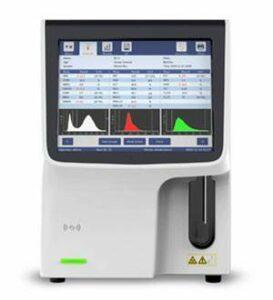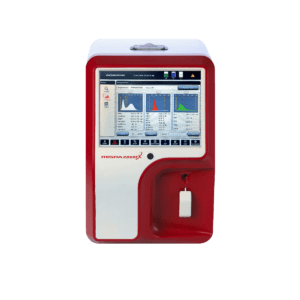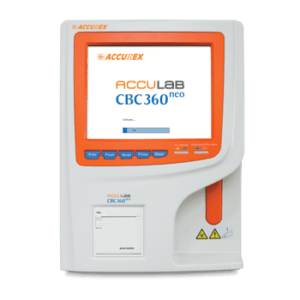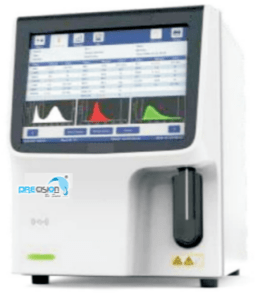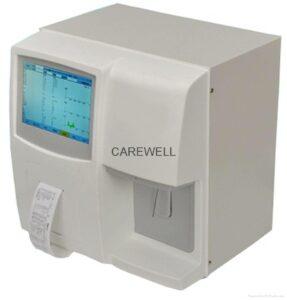Are you fascinated by the world of hematology analyzers and their role in revolutionizing blood cell analysis? Look no further! In this blog, we will delve into the fascinating realm of hematology analyzers and explore their types, advantages, applications, and common troubleshooting techniques. This blog will provide you the information you need to make wise selections, whether you’re a healthcare practitioner looking for accurate and effective blood cell analysis or a laboratory technician seeking trustworthy results.
But before we dive into the intricacies of hematology analyzers, let’s take a moment to introduce Medzell, a pioneering B2B platform that promotes Indian medical devices in emerging markets. Medzell, with its futuristic approach, aims to connect healthcare professionals, laboratory technicians, and medical institutions with cutting-edge technologies. With Medzell’s support, the Indian medical device industry is poised to make significant strides in providing advanced and reliable healthcare solutions worldwide.
Now, let’s embark on our journey through the world of hematology analyzers, exploring their types, advantages, applications, and troubleshooting techniques.
Types of Hematology Analyzers
Hematology analyzers come in a wide variety, each with a distinct set of features and capabilities. You may choose the analyzer that best suits your demands by being aware of the many types. Here are some of the key types of hematology analyzers:
- Benchtop Hematology Analyzer: Compact and efficient, benchtop analyzers offer convenience without compromising accuracy. Explore their advantages and applications in streamlining your hematology testing processes.
- Automated Hematology Analyzer: Experience the power of automation as we dive into the features and benefits of these advanced instruments. Discover how automated analyzers revolutionize blood cell analysis and improve laboratory efficiency.
- Point-of-Care Hematology Analyzer: Discover the importance of quick and accurate blood cell analysis in various healthcare settings. Explore the benefits of point-of-care analyzers and how they enhance patient care.
- Portable Hematology Analyzer: Flexibility and convenience are key factors in the fast-paced healthcare environment. Learn about portable analyzers and their applications, ideal for on-the-go healthcare professionals.
Advantages and Applications of Benchtop Hematology Analyzers
Benchtop hematology analyzers have gained popularity due to their compact size, efficiency, and accuracy. Let’s explore their advantages and discover how they can streamline your hematology testing processes:
- Streamlined Workflow: With benchtop analyzers, you can expect improved workflow efficiency, reduced turnaround time, and increased sample throughput.
- Compact Design: Their small footprint makes them ideal for laboratories with limited space. Despite their size, benchtop analyzers offer a wide range of functionalities.
- Ease of Use: Designed with user-friendly interfaces, these analyzers simplify the testing process, allowing technicians to obtain accurate results with minimal training.
- Versatility: Benchtop analyzers can handle a variety of samples, from whole blood to body fluids, enabling comprehensive hematology analysis.
- Applications: They find applications in various settings, including hospitals, clinics, research facilities, and veterinary practices, catering to a diverse range of testing needs.
Understanding Automated Hematology Analyzers
Automated hematology analyzers have revolutionized blood cell analysis by significantly improving efficiency, accuracy, and reliability. Let’s delve into their features and benefits:
- High Throughput: Automatic analyzers can process lots of samples quickly, relieving the workload of lab employees and facilitating quicker diagnosis.
- Full Analysis: These analyzers offer a detailed picture of the patient’s hematological profile via in-depth information about the red, white, and platelet blood cell characteristics.
- Flagging Systems: Advanced algorithms and flagging systems highlight abnormal results, drawing attention to potential hematological disorders and aiding in timely diagnosis.
- Reduced Manual Intervention: Automation minimizes manual errors and subjectivity, ensuring consistent and reliable results.
- Improved Accuracy: By employing sophisticated technology, automated analyzers minimize the risk of human error and provide highly accurate test results, crucial for accurate diagnoses and treatment plans.
- Laboratory Efficiency: With automated analyzers, laboratories can optimize their resources, reduce workload, and improve overall efficiency.
Now that we’ve explored the advantages of benchtop and automated hematology analyzers, let’s shift our focus to point-of-care and portable analyzers.
Simplifying Testing with Point-of-Care Hematology Analyzers
Quick and accurate blood cell analysis is crucial in the fast-paced healthcare environment. Point-of-care hematology analyzers play a vital role in providing on-the-spot results, allowing healthcare professionals to make immediate decisions regarding patient care. Let’s uncover their advantages and explore how they enhance healthcare delivery
- Rapid Results: Point-of-care analyzers deliver near-instantaneous results, enabling healthcare professionals to make timely decisions and provide immediate care.
- Convenience and portability: These analyzers can be used in a variety of healthcare environments, including emergency rooms, outpatient clinics, and distant sites.
- Reduced Turnaround Time: By eliminating the need for sample transportation and external laboratory testing, point-of-care analyzers significantly reduce the turnaround time, enabling faster diagnoses and treatments.
Improved Patient Care: With real-time results, healthcare providers may swiftly assess a patient’s condition, monitor therapy efficacy, and modify treatment plans as necessary, eventually leading to better patient outcomes.
Benefits of Portable Hematology Analyzers
In the era of mobility and convenience, portable hematology analyzers have become indispensable for healthcare professionals on the go. Let’s explore their advantages and understand why they are ideal for busy healthcare professionals:
- Flexibility and Portability: Portable analyzers can be easily carried to different locations, enabling healthcare professionals to perform blood cell analysis wherever and whenever needed.
- Real-Time Results: Obtaining immediate results empowers healthcare professionals to make informed decisions during emergencies, home visits, or in remote areas where access to laboratory facilities may be limited.
- Quality Performance: Portable analyzers offer accuracy and reliability comparable to their larger counterparts, ensuring consistent results without compromising on quality.
- Ease of Use: With intuitive interfaces and straightforward workflows, portable analyzers simplify the testing process, allowing healthcare professionals to focus on patient care rather than complex instrumentation.
- Versatility: From primary care physicians to mobile clinics and humanitarian missions, portable analyzers cater to a wide range of healthcare settings and professionals, providing quick and accurate blood cell analysis.
Now that we have explored the advantages and applications of various types of hematology analyzers, it’s essential to address common errors, calibration, maintenance, and quality control measures.
Common Hematology Analyzer Errors and Solutions
Despite their advanced technology, hematology analyzers can encounter errors that impact the accuracy and reliability of test results. Let’s delve into some common errors and effective solutions to troubleshoot these issues:
- Sample-Related Errors: Issues such as clots, hemolysis, or inadequate sample volume can lead to inaccurate results. Proper sample collection and handling techniques are essential to prevent these errors.
- Instrument-Related Errors: Analyzers may experience errors due to calibration issues, reagent problems, or mechanical malfunctions. Regular maintenance and adherence to calibration protocols can help resolve these errors.
- Software-Related Errors: Software glitches or compatibility issues can disrupt analyzer functionality. Keeping software up to date and promptly addressing any software-related issues is crucial.
- Interference and Artifacts: Substances present in the sample, such as lipids or abnormal cells, can cause interference and lead to erroneous results. Dilution or additional sample preparation steps may be required to overcome these issues.
By being aware of these common errors and implementing appropriate solutions, you can ensure the reliability of your testing and maintain accurate results.
The Importance of Hematology Analyzer Calibration
Calibration is a crucial step in ensuring precise and consistent blood cell analysis. It involves adjusting the analyzer’s parameters to align with reference values, thereby minimizing measurement discrepancies. Let’s understand the significance of calibration and its impact on test accuracy:
- Accuracy Assurance: Calibration ensures that the analyzer provides results within an acceptable range of deviation from the reference values, ensuring accuracy and reliability.
- Standardization: Calibration allows for standardization across different analyzers, enabling comparability of results among laboratories and institutions.
- Traceability: Calibration allows results to be traceable to internationally recognized standards, ensuring consistency and comparability across different testing facilities.
- Quality Control Compliance: The highest standards of performance are maintained by the analyzer through calibration, which is a crucial component of quality control procedures.
By following calibration protocols and regular calibration schedules, laboratories can achieve precise and consistent blood cell analysis, contributing to accurate diagnoses and effective treatment plans.
Essential Maintenance Tips for Hematology Analyzers
To ensure optimal performance and longevity of your hematology analyzer, regular maintenance is crucial. Here are some essential maintenance tips to maximize the lifespan of your instrument and prevent downtime:
- Cleaning and Decontamination: Regularly clean and decontaminate the analyzer to prevent sample carryover and maintain accurate results. Follow manufacturer guidelines and use recommended cleaning agents.
- Quality Control Monitoring: Implement a robust quality control program to monitor the analyzer’s performance, identify any deviations, and take corrective actions promptly.
- Reagent Management: Proper storage and handling of reagents are essential to maintain their integrity and ensure accurate test results. Follow manufacturer instructions for storage conditions and shelf life.
- Preventive Maintenance: Adhere to the manufacturer’s recommended preventive maintenance schedule. Regular inspections, part replacements, and calibrations will help identify potential issues before they become significant problems.
- Training and Education: Ensure that laboratory staff receives proper training on instrument operation, maintenance procedures, and troubleshooting techniques. Well-informed technicians can proactively address issues and optimize analyzer performance.
By following these maintenance tips, you can minimize downtime, prevent errors, and maximize the lifespan of your hematology analyzer, ultimately improving laboratory efficiency.
Ensuring Quality Control in Hematology Analysis
Maintaining accurate and reliable results in hematology analysis relies on effective quality control measures. Let’s explore the significance of quality control and the methods and procedures for ensuring the integrity of your laboratory’s hematology testing:
- Internal Quality Control: Regularly analyze control samples with known values to assess the accuracy and precision of your hematology analyzer. Document and analyze the results to identify trends or deviations that require corrective actions.
- External Quality Assessment: Participate in external proficiency testing programs to benchmark your laboratory’s performance against other facilities. External assessments provide valuable insights into your analyzer’s accuracy and comparability with other laboratories.
- Documentation and Review: Maintain comprehensive records of quality control data, calibration records, and corrective actions taken. Regularly review the data to identify trends and implement necessary improvements.
- Staff Competency: Ensure that laboratory staff receives proper training on quality control procedures and is familiar with the analyzer’s specifications and limitations. Continuous education and competency assessments contribute to reliable results.
By implementing robust quality control measures, you can maintain the accuracy and reliability of your hematology testing, instilling confidence in your laboratory’s results and contributing to patient care.
Resolving Software Issues in Hematology Analyzers
Software-related issues can hinder the seamless operation of hematology analyzers, impacting the accuracy and efficiency of blood cell analysis. Let’s explore common software issues encountered and discover effective solutions to address them:
- Compatibility Issues: Ensure that the analyzer’s software is compatible with the operating system and other connected devices. Regularly update the software to address compatibility issues and benefit from the latest features and bug fixes.
- Error Messages and Alerts: Familiarize yourself with the analyzer’s error messages and alerts. Consult the analyzer’s manual or contact technical support for guidance on resolving specific software-related issues.
- Data Management and Connectivity: Ensure that the analyzer’s data management system functions properly, enabling seamless data transfer and integration with laboratory information systems (LIS) or electronic medical records (EMR) systems.
- Software Updates and Patches: Keep up with the most recent software patches and updates that the manufacturer provides. These updates often address software bugs, and security vulnerabilities, and enhance overall performance.
- Technical Support and Training: Maintain a good rapport with the manufacturer’s technical support team. Seek their guidance when encountering software-related issues and ensure that laboratory staff receives adequate training on software usage and troubleshooting techniques.
By addressing software issues promptly and proactively, you can ensure the smooth operation of your hematology analyzer, minimize downtime, and obtain accurate and reliable blood cell analysis results.
Exploring Common Hematology Disorders
To fully understand the significance of hematology analyzers and blood cell analysis, it’s essential to explore common hematology disorders. Let’s gain insights into some prevalent disorders, including their causes, symptoms, and treatment options:
- Anemia: Weakness, tiredness, and shortness of breath are symptoms of anemia, which is characterized by a deficiency in red blood cells or hemoglobin. It may result from dietary deficiencies, chronic illnesses, or inherited issues. Treatment options include iron supplementation, blood transfusions, or addressing the underlying cause.
- Leukemia: A class of malignancies known as leukemia affects the bone marrow and blood-forming cells. It leads to abnormal production of white blood cells, causing symptoms such as fatigue, frequent infections, and easy bleeding. Among the available treatments include chemotherapy, radiation therapy, and stem cell transplantation.
- Thrombocytopenia: Decreased platelet levels, which increase the risk of bleeding and bruising, are a defining feature of thrombocytopenia. Its onset may be caused by a variety of reasons, such as autoimmune illnesses, adverse drug reactions, and underlying medical issues. Treatment options may include medication, platelet transfusions, or lifestyle modifications depending on the underlying reason.
- Hemophilia: Hemophilia is a hereditary condition defined by a deficit in particular clotting components, which causes excessive bleeding and postponed clot formation. Treatment involves replacing the deficient clotting factors through infusions, managing bleeding episodes, and adopting preventive measures.
These are just a few examples of the wide range of hematology disorders that hematology analyzers help diagnose and monitor. By understanding these disorders, healthcare professionals can provide timely and appropriate treatment to patients.
Hematology Analyser from Leading Indian Manufacturer
Hestia 360
Hestia 360: Recorders & Medicare Systems Pvt. Ltd manufactures the Hestia 360, a highly efficient and cost-effective 3 Part Auto Hematology Analyzer, designed to deliver accurate results. This advanced analyzer is offered at a reasonable price, making it accessible to a wide range of healthcare facilities. With 21 parameters and 3 histograms, the Hestia 360 provides a comprehensive analysis of blood samples. Its automatic cleaning feature ensures the sample probe remains free from any residue, minimizing the risk of cross-contamination. The device boasts a user-friendly interface, featuring a 10.4-inch color graphical touchscreen display that allows for easy navigation and result interpretation. To ensure reliable performance, the Hestia 360 incorporates a high-voltage shock and back-flush mechanism, effectively eliminating any clogs that may occur during operation. Additionally, its floating boundary algorithm for histograms includes an abnormal prompt function, aiding in the detection of any irregularities. The Hestia 360 utilizes the cyanide-free SFT method to measure the hemoglobin parameter, ensuring safe and accurate results. With two reagents, diluent and lyse, this analyzer provides complete and precise hematology analysis.
Mispa Count X
Mispa Count X: Agappe Diagnostics Limited introduces the Mispa Count X, an Automated 3-part Differential Hematology Analyzer that offers a cost-effective solution for blood analysis. Designed to meet the needs of routine laboratories, satellite labs, and emergency care units, the Mispa Count X delivers high-quality Complete Blood Count (CBC) testing. This analyzer operates on the principles of Electrical Impedance, Volumetric Metering, and Photometry/Colorimetry, ensuring accurate and reliable results. The Mispa Count X has a great throughput of 60 samples per hour, allowing for efficient workflow management. With 20 parameters and 3 histograms, it provides a comprehensive analysis of blood samples. Agape Diagnostics Limited offers a range of reagents specifically designed for use with the Mispa Count X. The system reagents, such as Lyse (LX3) and Probe Cleaner (PX3), ensure optimal performance and longevity of the analyzer. Calibration and control reagents, including Hematology Calibrator and Hematology Control (Tri Level), further enhance the accuracy and precision of the Mispa Count X.
ACCULAB CBC 360-NEO
Introducing the ACCULAB CBC 360-NEO, a cutting-edge offering from Accurex Biomedical Pvt. Ltd, is renowned for its exceptional line of Automated Hematology Analyzers This innovative analyzer incorporates automation features that streamline the testing process, providing convenience and efficiency. The walkaway process is supported by various automated functions, including self-check, blanking, printing, sleep mode, alarm, and cleaning. The ACCULAB CBC 360-NEO is designed with dual chambers, facilitating simultaneous testing and reducing turnaround time. Its twin chamber WBC differentiation ensures accurate and reliable results. The analyzer provides a comprehensive panel of 21 parameters, conveniently grouped by the type of corpuscle for efficient reporting. With a modest sample volume requirement of 10 ml for whole blood in venous mode and 20 ml for pre-diluent in capillary mode, it is capable of accommodating pediatric testing in the pre-diluted mode. The ACCULAB CBC 360-NEO features an audio alert system, promptly notifying users of unusual findings or system faults. The device incorporates direct command keys for quick access to various functions, ensuring a user-friendly experience. With high voltage cautery for probe cleaning and a dormancy mode to conserve energy, the ACCULAB CBC 360-NEO is a reliable and environmentally conscious choice.
PRECICELL – 300 Pro
PRECICELL – 300 Pro: Precision Biomed Private Limited introduces the PRECICELL – 300 Pro, an automated hematology analyzer designed for accurate and efficient blood analysis. Manufactured in India and globally supplied, this device offers advanced features to meet the needs of modern healthcare facilities. The PRECICELL-300 Pro is compatible with two modes of blood sampling, allowing for flexibility in sample collection. The device incorporates a range of connectivity options, including a thermal printer, expandable laser printer or ink-jet printer, 4 USB ports, 1 LAN port, and support for the HL7 protocol and LIS connectivity. The intuitive design features a 10.4-inch touchscreen display with an 800 x 600 resolution, providing a clear and user-friendly interface. Automatic probe and tube cleaning, along with fault processing capabilities, make the device easy to maintain. With only two reagents required and a processing capacity of 60 samples per hour, the PRECICELL – 300 Pro offers efficiency without compromising accuracy. The analyzer provides a comprehensive panel of test parameters, including WBC, RBC, HGB, PLT, and 3 histograms, enabling a detailed analysis of blood samples.
The CARECELL-23
The CARECELL-23 Hematology Analyzer, developed by CAREWELL Biotech Pvt. Ltd., is a state-of-the-art medical device that revolutionizes hematology analysis. This fully automated system offers unparalleled accuracy and speed, making it an indispensable tool for healthcare professionals. With its advanced features and robust performance, the CARECELL-23 ensures precise and reliable results for comprehensive blood cell analysis. Let’s explore the remarkable capabilities of this remarkable device.
Conclusion
Hematology analyzers are vital instruments in the field of diagnostics, providing comprehensive blood cell analysis for the diagnosis and management of various hematological disorders. Whether it’s benchtop analyzers for efficient laboratory testing, automated analyzers for improved efficiency, point-of-care analyzers for quick results, or portable analyzers for on-the-go professionals, there is a wide range of options to cater to diverse needs.
To further support the medical industry, platforms like Medzell have emerged as futuristic B2B platforms that promote Indian medical devices in emerging markets. Medzell connects medical device manufacturers, distributors, and buyers, facilitating efficient trade and fostering collaborations in the healthcare industry. Through platforms like Medzell, the availability, and accessibility of advanced medical devices, including hematology analyzers, are enhanced, benefiting healthcare professionals and patients alike.
By understanding the different types of hematology analyzers, their advantages, and applications, as well as addressing common errors, calibration, maintenance, and quality control measures, laboratories can ensure accurate and reliable blood cell analysis. This contributes to more precise diagnoses, effective treatment plans, and improved patient outcomes in the field of hematology.

